Non-Toxic Vole Removal: Safe Strategies for Homes
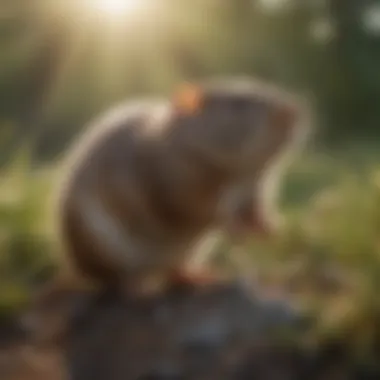
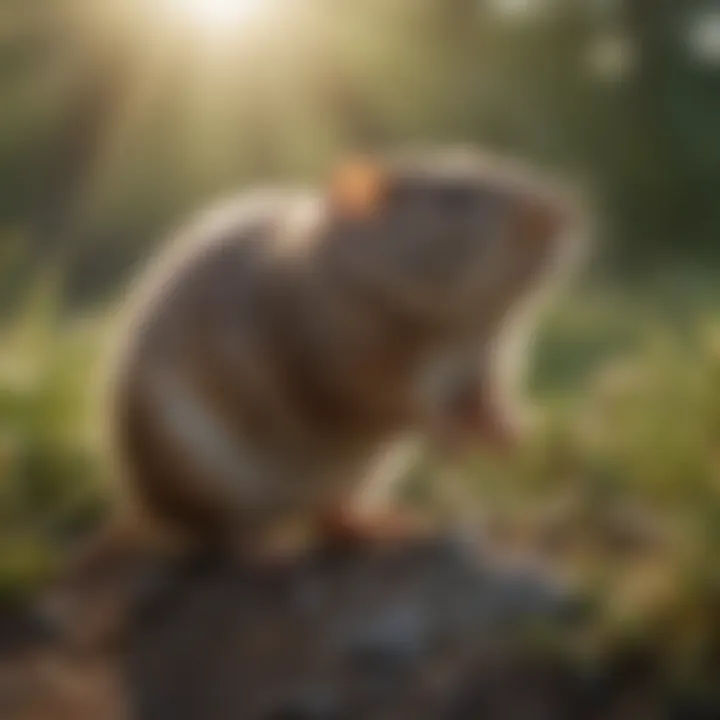
Intro
Voles, small rodents belonging to the Cricetidae family, are known for their burrowing habits and can become a headache for homeowners and gardeners alike. These creatures can cause significant damage to gardens, lawns, and even the foundations of homes. Their presence not only disrupts the aesthetics of a landscape but also poses risks to plants and crops. Understanding their behavior and identifying their signs of infestation is crucial for implementing effective removal strategies.
Understanding Voles
Understanding voles is essential for anyone facing infestation issues. This section outlines their biology, behavior, and environmental impact. Knowing how voles operate helps in effective management and removal strategies, ensuring that actions taken are environmentally friendly and sustainable.
Biology and Behavior
Physical characteristics
Voles are small mammals that belong to the rodent family. Their key physical traits include short tails, small ears, and stocky bodies. Typically, they measure about 4 to 10 inches long, featuring fur that varies from brown to grayish in color. This specific aspect of voles allows them to blend into their surroundings, making detection difficult.
Their size makes them a popular choice for study because their population has significant implications for local ecosystems. The unique feature of their physicality is that they reproduce quickly, leading to potential overpopulation. Thus, understanding these characteristics is beneficial for homeowners facing problems with voles in their yards or gardens.
Habitat preferences
Voles prefer habitats that offer plenty of cover. They are often found in grasslands, woodland edges, and gardens. This key characteristic of habitat preference allows them to thrive in cultivated areas, which leads to a need for effective control measures. Their unique feature is the construction of extensive burrow systems that provide shelter from predators.
The advantages of understanding their habitat preferences include targeting removal strategies in the right areas, such as thick grassy parts of the garden or near shrubs. Recognizing where voles live helps implement better preventative actions.
Feeding habits
Voles are herbivores, primarily consuming grass, seeds, and roots. Their key feeding habits include gnawing on a variety of plants, including valuable garden specimens. It is essential to note that voles can cause extensive damage to gardens due to their appetite. This specific aspect of their behavior contributes to their status as pests.
A distinctive feature of their feeding habits is the creation of distinct feeding tunnels in vegetation. These not only help in locating their pathways but also indicate areas that require attention. Understanding these habits leads to better planning to minimize plant damage.
Impact on Gardens and Lawns
Damage to plants
Voles can be devastating to domestic gardens. They enjoy munching on roots and bulbs, which can severely hinder plant growth. Their key characteristic is their tendency to eat both established plants and seedlings. This characteristic makes them a significant threat. Homeowners see the impact immediately when plants begin to wither without obvious signs.
This unique feature of damaging plants emphasizes the urgent need for control measures to protect gardens, especially during the growing season. Recognizing the potential for destruction motivates homeowners to act more decisively against voles.
Burrowing behavior
The burrowing habits of voles lead to various problems for lawns and gardens. They create intricate tunnel systems that can compromise soil stability. This key aspect of their behavior can affect root systems of plants and even lead to unsightly patches of dead grass.
Additionally, the unique feature of their burrowing is that it can lead to uneven terrain, making areas difficult to navigate. Homeowners often find this behavior frustrating and may result in a need for additional landscaping work to repair damage.
Long-term consequences
Understanding the long-term consequences of vole infestation is critical. If left unchecked, voles can establish large populations that become challenging to eliminate. This key characteristic highlights the risk of lasting damage to plant life and garden aesthetics.
Over time, repeated damage can result in barren patches that take considerable effort to restore. The unique feature is the potential for voles to harm not just individual plants but entire garden ecosystems. Thus, early intervention and consistent monitoring become essential for maintaining garden health.
Preventing Vole Infestation
Preventing a vole infestation is a key aspect of maintaining a healthy garden and landscape. By implementing proactive measures, homeowners can reduce the chances of voles invading their spaces. This section focuses on specific methods for controlling potential vole populations before they establish themselves. Using strategies such as proper plant selection, garden hygiene, and physical barriers can create an environment less appealing to these pests.
Sustainable Landscaping Practices
Choosing resistant plant species
Choosing resistant plant species involves selecting plants that are less attractive to voles. This approach contributes significantly to the overall goal of managing vole populations. Resistant plants often have tougher textures or chemical compositions that deter voles from feeding on them. These species can include certain grasses, bulbs, and perennial flowers that have developed natural defenses against herbivores.
A key characteristic of this strategy is its long-term benefit. By planting species that voles naturally avoid, one can safeguard their gardens more effectively than simply relying on chemical deterrents. For example, plants like daffodils and alliums are known to be unpalatable to voles. They help maintain the aesthetic of a garden while reducing the risk of rodent damage.
However, not all resistant plants thrive in every environment. Homeowners should assess the specific conditions of their gardens, including soil type and sunlight, when choosing these plants to ensure they will flourish.
Maintaining proper garden hygiene
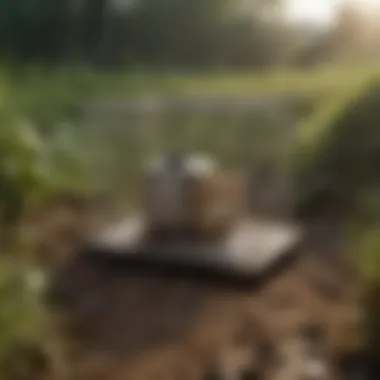

Maintaining proper garden hygiene plays an essential role in vole prevention. This practice involves regular maintenance, such as cleaning up fallen fruits, vegetables, and other organic materials that may attract voles. Keeping the garden tidy reduces potential food sources for these pests, thereby discouraging them from nesting nearby.
The key characteristic here is the emphasis on cleanliness. An organized garden not only looks better, but it also minimizes the chances of infestations. Moreover, consistent garden maintenance can help identify early signs of vole activity, allowing for timely intervention if necessary.
A unique aspect of maintaining hygiene is managing compost piles. While compost is beneficial for soil health, improper management can attract voles. Ensure compost piles are well-contained and regularly aerated.
Implementing physical barriers
Implementing physical barriers is a practical method to prevent voles from entering specific areas of a garden. Barriers can include wire fencing, mesh, or hardware cloth installed around garden beds. These obstacles physically impede voles' access to plants and undermine their ability to burrow.
The strength of this method lies in its effectiveness; a well-constructed barrier can truly keep voles at bay without using harmful chemicals. Fencing should be buried several inches underground to stop voles from burrowing beneath it.
However, it is important to consider the potential drawbacks. Physical barriers require time and effort to install, and regular maintenance is necessary to ensure they remain intact. Homeowners must also be mindful of local wildlife that could get trapped or harmed by these barriers.
Habitat Modification
Removing shelter and cover
Removing shelter and cover is crucial in making the area less inviting to voles. This strategy entails clearing away dense vegetation, tall grasses, and brush piles where voles might seek shelter. By eliminating these hiding spots, the risk of attracting voles diminishes, creating an unfriendly environment for them.
The key aspect here is the reduction of potential nesting sites. Voles prefer areas where they can hide from predators. A clean landscape not only deters voles but also improves overall garden appearance.
A unique feature of this approach is the instant effect of visual cleanliness. Removing excess cover can drastically change the environment, making it less attractive to pests. However, care must be taken to avoid disrupting beneficial wildlife that may also inhabit these areas.
Managing excess vegetation
Managing excess vegetation involves keeping plants trimmed and manageable. Overgrowth can provide cover for voles to move through the garden undetected. By regularly pruning back plants and grasses, homeowners can make their gardens less hospitable.
The significance of managing excess vegetation stems from the goal of maintaining a healthy garden ecosystem. This practice not only helps to deter voles but also promotes the growth of healthier plants. Ensuring that vegetation does not become overgrown can also improve air circulation and sunlight penetration.
Another unique aspect is that this method encourages diverse plant life. A well-maintained garden with varied vegetation can draw beneficial insects and birds, promoting a balanced ecosystem.
Reducing food availability
Reducing food availability is a vital part of vole control. One way to do this is by minimizing access to roots, bulbs, and other edible plants that voles favor. Gardeners should consider implementing practices like rotating crops or storing tubers and bulbs in secure settings.
The key feature of this method lies in its direct impact on vole populations. Fewer food sources can result in an overall decline in local vole numbers. Gardeners must ensure that fallen fruits and vegetables are promptly cleared away as well.
However, one downside of implemented practices may be the additional effort required for proper garden management. Regular attention is necessary to ensure that food sources do not re-emerge, but diligent management can lead to lasting benefits in pest control.
Non-Poisonous Trapping Techniques
Trapping voles stands as a key method in managing their populations without using harmful chemicals. This part of pest control emphasizes targeting the problem effectively while maintaining an eco-friendly approach. Trapping can be more humane, as it allows for the removal of the pests without causing unnecessary suffering. The benefits of non-poisonous trapping include safety for pets and children, protecting beneficial wildlife, and reducing chemical exposure in home and garden environments.
Understanding various types of traps is essential; each type serves unique purposes and offers different advantages. It is also crucial to set traps in locations where they are most effective to increase chances of catching voles. Additionally, checking traps frequently ensures that captured voles do not suffer, promoting a quick response to control measures.
Types of Traps
Snap traps
Snap traps are among the most traditional methods for vole removal. One of their primary characteristics is the quick action mechanism that kills the vole instantly upon contact. This contributes positively to the goal of removing voles efficiently, making them a popular choice for many homeowners.
Another unique feature of snap traps is their simplicity. They require no special equipment and can be placed nearly anywhere. However, there are disadvantages. Improper placement may lead to missed captures, and there is a risk of accidentally harming non-target animals if they are not monitored closely. Proper placement is important to mitigate these downsides.
Live capture traps
Live capture traps provide a humane way to deal with voles. A key characteristic of these traps is their ability to confine the animal without causing injury or death. This method aligns well with the increasing preference for humane treatment of wildlife. The unique feature of live capture traps is that they enable relocation of the voles to newly selected environments away from residential areas.
Despite these benefits, there are challenges associated with live capture traps. You must check them frequently to prevent stress to the trapped voles and also to ensure that they do not attract additional rodents. This method requires commitment in time and effort but can be worth it for those who prioritize humane methods.
Electronic traps
Electronic traps are a modern innovation in pest control. The main characteristic of electronic traps is their ability to deliver a quick electric shock to rodents, resulting in instant death. This aligns with the demand for effective and humane solutions.
Moreover, electronic traps often come with features such as indicator lights showing whether a rodent has been captured, which simplifies the monitoring process. They are also reusable and can be more sanitary than other methods. However, they require batteries and can be more expensive than traditional traps. These factors make them a consideration for those willing to invest in more sophisticated equipment.


Setting Traps Effectively
Optimal locations for traps
The effectiveness of trapping voles hinges heavily on the placement of the traps. Identifying optimal locations significantly increases success rates. Traps should be set along runways where voles frequently travel, often indicated by worn paths or droppings. This approach ensures that the traps operate where voles are most active, thus enhancing capture rates.
A notable aspect of this method is considering environmental factors. Weather conditions, seasonal activity, and food sources all play crucial roles in where voles will be found. Better location strategies lead to higher possibility of successful trapping.
Proper bait selection
Using the right bait is essential in ensuring that traps attract voles effectively. The selection of bait should consider what voles naturally consume. Many recommend using peanut butter, birdseed, or even pieces of fruits, as these attract voles strongly. This choice is vital; without appealing bait, traps may remain unvisited.
Furthermore, bait must be secured appropriately within traps to prevent it from being stolen without triggering the trap. Inadequate bait handling can lead to wasted efforts and less effective traps.
Tips for checking traps frequently
Regular monitoring of traps is critical for humane vole control. The frequent checking of traps minimizes stress and suffering for trapped animals. It also allows prompt removal of captured voles, aiding in timely pest control.
Typically, traps should be checked at least once every 24 hours. This practice not only shows compassion towards the wildlife but also improves the effectiveness. If traps are not consistently monitored, it could lead to rodents escaping or to poor conditions for captured animals. Routine checking builds a more effective trapping strategy overall.
Natural Repellents for Voles
Natural repellents offer a compelling approach for managing vole populations without the use of toxic substances. These methods are particularly significant for those who prioritize environmental safety and seek to maintain their gardens and landscapes without harming beneficial wildlife. Repellents can deter voles more naturally, helping to create a balanced ecosystem while addressing a challenging pest problem. Moreover, the use of repellents can be part of a larger strategy that includes prevention and trapping, making them an essential component in a holistic pest management plan.
Essential Oils and Natural Sprays
Peppermint oil effectiveness
Peppermint oil is renowned for its strong scent, which is highly aversive to voles. The oil’s distinct aroma disrupts the animal's sense of smell, leading them to avoid areas treated with it. This makes peppermint oil a beneficial choice for natural vole deterrence. Its effectiveness lies in its ability to mask natural odors that voles rely on for navigation.
The unique feature of peppermint oil is its dual role as both a repellent and an aromatic enhancement for the garden. However, disadvantages include its relatively short-lived effectiveness in outdoor conditions and the need for frequent reapplication, especially after rain.
Using castor oil
Castor oil also serves as an effective repellent against voles. It works by creating an unpleasant taste and smell that voles find intolerable. This characteristic makes it a popular option among gardeners looking for non-toxic methods. Castor oil is particularly advantageous because it tends to persist longer in the soil compared to other oils.
One unique feature of castor oil is its ability to deter other pests, thus offering multiple benefits. However, it can stain surfaces and attract other wildlife, which might be considered a disadvantage for some users.
Recipes for homemade repellents
Making homemade repellents can provide a cost-effective and customizable solution for homeowners. Simple recipes often involve combining essential oils with water and a mild soap as an emulsifier. This beneficial method allows individuals to create a tailored mixture suited to their specific garden conditions.
A unique feature of homemade repellents is the ability to experiment with different natural ingredients, allowing the user to adapt the response based on effectiveness. On the downside, efficacy can vary widely based on the ingredients used, and consistent application is needed to maintain effectiveness against voles.
Plant-Based Deterrents
Utilizing strong-smelling herbs
Integrating strong-smelling herbs in the garden can serve as a natural barrier against voles. Herbs such as sage, lavender, and rosemary are notable options due to their pungent aromas that repel many rodents. These plants not only contribute to pest control but also enhance the garden’s aesthetic.
The key characteristic of using these herbs is their ability to provide continuous protection, as they grow and spread naturally. However, it's important to note that they might not be sufficient on their own for severe infestations.
Integrating deterrent plants into gardens
Incorporating plants known for their repelling qualities can create a protective environment for more vulnerable crops. Examples include planting garlic or marigolds around the perimeter of the garden. This strategic approach is beneficial because it reinforces natural pest resistance.
The unique feature here is the integration of aesthetics with pest control. However, there may be limitations with compatibility for certain types of vegetables, where relatively invasive species might outcompete desired plants.
Benefits of companion planting
Companion planting maximizes the benefits of natural repellents by positioning plants together in ways that promote growth while minimizing pest attraction. It is a beneficial practice that enhances biodiversity and can significantly reduce the likelihood of vole infestations.
The unique characteristic of companion planting is its holistic approach, which leads to improved stability and health of the garden ecosystem as a whole. Nonetheless, careful planning and knowledge about plant pairings are essential, or the technique may fall short of expectations.
Monitoring and Assessment
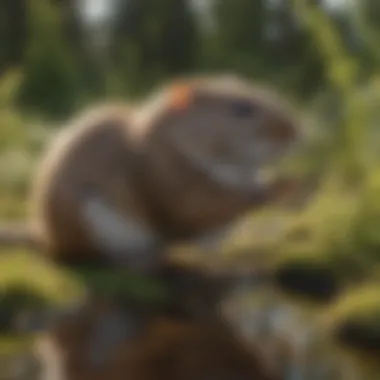
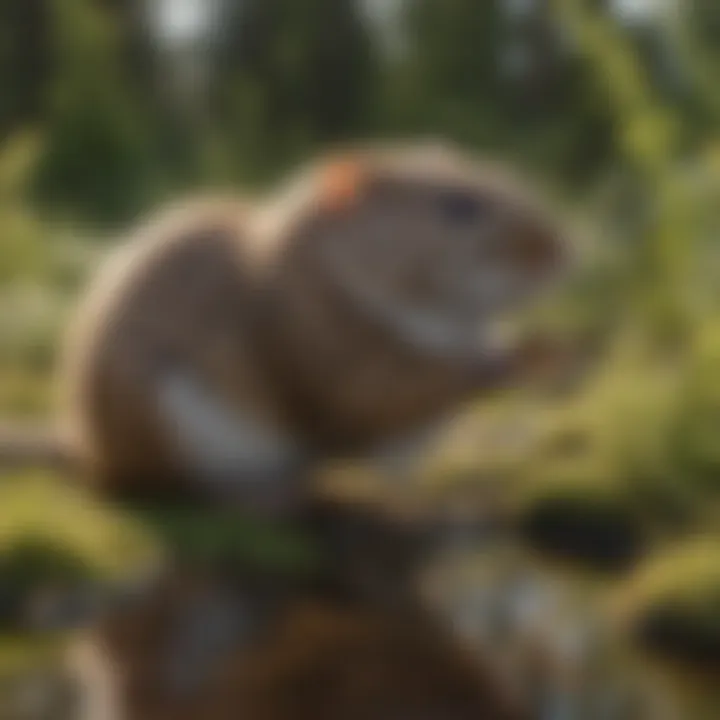
Effective monitoring and assessment form the cornerstone of any successful vole removal strategy. Understanding the signs of vole activity can inform management decisions and enable homeowners to take appropriate action. This process involves careful observation and evaluation, ensuring that methods employed are genuinely effective.
Monitoring can involve a variety of techniques, each with unique benefits. The goal is to identify vole populations accurately and assess the success of implemented control measures. Without proper monitoring, efforts may be misguided, wasting time, resources, and potentially exacerbating the infestation.
Identifying Signs of Vole Activity
Recognizing burrows and tunnels
Recognizing burrows and tunnels is crucial in identifying vole habitats. Voles create extensive tunnel systems underground, allowing them to travel and store food. These burrows usually have a shallow entrance that may be located close to plants. Spotting these features can guide homeowners in locating vole populations.
The main characteristic of these tunnels is their unique appearance, which often resembles small holes in the ground. This clear identification of burrows makes it easier to pinpoint areas in need of intervention. Recognizing burrows and tunnels allows for a targeted approach, which is efficient and saves time.
However, it is important to understand that while this method is effective, it may not always provide a complete picture of the vole presence. Some burrows can be abandoned or inhabited by other creatures, leading to potential misinterpretations.
Observing feeding patterns
Observing feeding patterns involves looking for signs of vole activity around specific plants or garden areas. This is essential for understanding which plants are at risk and helps in planning preventive measures or responses. Voles leave distinct chew marks on stems and leaves, providing clear indicators of their presence.
The key characteristic here is the easily recognizable munching marks, which confirms feeding activity. By focusing on these patterns, homeowners can safeguard prioritized plants, making this observation a beneficial choice for effective vole management.
Nonetheless, while observing feeding patterns can be quite useful, it may not reveal the full extent of an infestation, especially in vast gardens.
Tracking droppings and scent trails
Tracking droppings and scent trails can provide further evidence of vole activity. Vole droppings are small, dark, and cylindrical in shape, typically found near entry points or feeding areas. This allows for quick assessments of vole presence and helps in corroborating other signs.
The key characteristic here is the distinct appearance of droppings, which can indicate not only the presence of voles but also the level of activity. This method is popular among gardeners as it requires minimal effort. However, feces can decay and blend into the environment, sometimes complicating identification.
Evaluating Control Measures
Assessing efficacy of traps and repellents
Assessing the efficacy of traps and repellents is important to ensure that methods used are effective. After deploying traps or repellents, homeowners should review the results regularly. This allows for identifying which methods are working effectively and which are not.
One unique feature of this assessment is the ability to refine ongoing strategies based on outcomes. By focusing on results, homeowners can optimize their efforts towards the most successful methods.
However, this effort requires some time and commitment for evaluation. If not monitored correctly, there is a risk of complacency, leading to potentially ineffective strategies being maintained unintentionally.
Adjustments to strategies as needed
Making adjustments to strategies involves adapting management efforts based on the insights gained from assessment. This ensures tactics remain relevant and effective against evolving vole behavior. Flexibility is a key component of successful management.
The benefit of being adaptable lies in the ability to respond to dynamic environments and vole behavior changes. This proactive stance can prevent further infestations and promote long-term garden health.
However, constant changes can sometimes confuse overall strategies, leading to inconsistencies. Hence, adjustments should be based on clear evaluation criteria.
Documenting and reporting success
Documenting and reporting success creates a comprehensive record of all management actions. Such documentation can help identify successful techniques, which can be shared with others facing similar issues. By logging outcomes, individual experiences contribute to a collective knowledge base on non-poisonous vole removal.
This key characteristic fosters a shared sense of community among homeowners, allowing them to learn from each other's experiences. The unique aspect of this method is its potential to build a support network for sharing successful practices.
However, documenting efforts can questionably feel burdensome, possibly discouraging some individuals. Thus, finding a balance between thorough documentation and practical management is essential.
The End
Summarizing Effective Strategies
Holistic approach to vole management
A holistic approach to vole management considers various factors in the environment. This method combines trapping, barriers, and natural repellents to create a multi-faceted strategy. Such an approach is beneficial because it does not rely on a single method, thus diversifying options and improving effectiveness. The key characteristic of this method is its reliance on preventive measures instead of reactive ones. One unique feature of this approach is its ability to adapt to different circumstances, which can be advantageous in various residential settings.
Importance of ongoing vigilance
Ongoing vigilance is essential to maintaining an vole-free environment. This aspect refers to the continual assessment of vole activity and the effectiveness of control measures. Regular monitoring helps identify new infestations early, which can prevent larger issues later on. Its key characteristic is the proactive nature it demands from homeowners. One unique feature of ongoing vigilance is that it enables a dynamic response to vole populations, thus giving homeowners the ability to adapt strategies as needed. This can be advantageous, as it reduces the long-term damage caused by voles.
Encouragement of ecosystem balance
Encouraging ecosystem balance ties into the overall goal of this article. It involves integrating vole management into the larger picture of garden care and pest control. The key characteristic here is the respect for all living organisms. This approach not only considers how to manage voles but also how these efforts affect other wildlife. The unique feature is its focus on coexistence, rather than elimination. This can have advantages in promoting biodiversity and ensuring that the garden remains vibrant and healthy.
In summary, effective strategies for vole management should always embrace a holistic ethos, maintain consistent vigilance, and foster ecological balance. This comprehensive approach offers sustainable benefits and a peaceful coexistence with nature.



